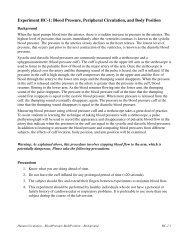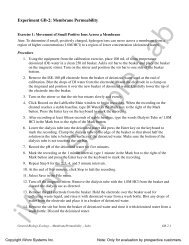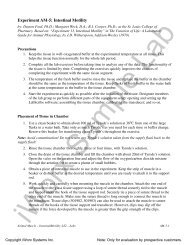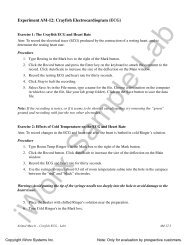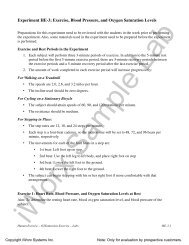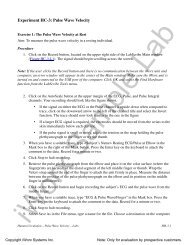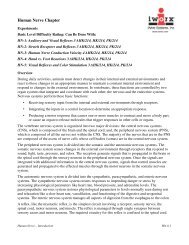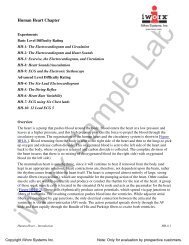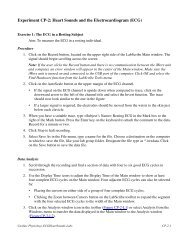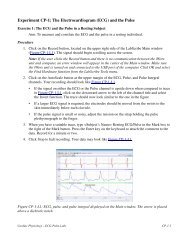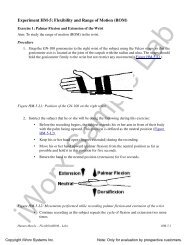Experiment RP-2: The Effect of Gravity on Breathing - iWorx
Experiment RP-2: The Effect of Gravity on Breathing - iWorx
Experiment RP-2: The Effect of Gravity on Breathing - iWorx
- No tags were found...
You also want an ePaper? Increase the reach of your titles
YUMPU automatically turns print PDFs into web optimized ePapers that Google loves.
Data Analysis-Forced Expirati<strong>on</strong> at Rest1. Use the slider or the arrows <strong>on</strong> the scroll bar, at the bottom <str<strong>on</strong>g>of</str<strong>on</strong>g> the Analysis window, to positi<strong>on</strong>data recorded when the subject exhaled with maximum force in the window.2. Use the Display Time ic<strong>on</strong>s to adjust the Display Time <str<strong>on</strong>g>of</str<strong>on</strong>g> the Analysis window to show theforced expirati<strong>on</strong> curve and the two normal breaths, that occur before the force expirati<strong>on</strong> curve,<strong>on</strong> the same window. <str<strong>on</strong>g>The</str<strong>on</strong>g>se breathing cycles can also be selected by:• Placing the cursors <strong>on</strong> either side <str<strong>on</strong>g>of</str<strong>on</strong>g> the group <str<strong>on</strong>g>of</str<strong>on</strong>g> appropriate breathing cycles; and• Clicking the Zoom between Cursors butt<strong>on</strong> <strong>on</strong> the LabScribe toolbar to expand the selectedbreathing cycles to the width <str<strong>on</strong>g>of</str<strong>on</strong>g> the Main window.<str<strong>on</strong>g>The</str<strong>on</strong>g> segment <str<strong>on</strong>g>of</str<strong>on</strong>g> the recording displayed inthe window should be like the recording in Figure <str<strong>on</strong>g>RP</str<strong>on</strong>g>-2-L5.3. Use the same techniques used earlier to record volumes in the Journal by:• Typing the names and values <str<strong>on</strong>g>of</str<strong>on</strong>g> the parameters directly into the Journal, or;• Transferring the names and values <str<strong>on</strong>g>of</str<strong>on</strong>g> the parameters into the Journal by using the Add Titleto Journal and the Add Ch. Data to Journal functi<strong>on</strong>s in the Volume Channel menu.4. Place the cursors <strong>on</strong> the forced expirati<strong>on</strong> data displayed <strong>on</strong> the Volume channel to measure thefollowing volumes using the V2-V1 and T2-T1 functi<strong>on</strong>s. Check the labels <strong>on</strong> Figure <str<strong>on</strong>g>RP</str<strong>on</strong>g>-2-L5to identify the volumes that you will measure:• Tidal Volume (TV), by placing <strong>on</strong>e cursor in the trough before the inhalati<strong>on</strong> segment <str<strong>on</strong>g>of</str<strong>on</strong>g> theresting breath and the sec<strong>on</strong>d cursor <strong>on</strong> the peak <str<strong>on</strong>g>of</str<strong>on</strong>g> that resting breath cycle. <str<strong>on</strong>g>The</str<strong>on</strong>g> value forthe V2-V1 functi<strong>on</strong> <strong>on</strong> the Volume channel is the tidal volume.• Inspiratory Reserve Volume (IRV), by placing <strong>on</strong>e cursor <strong>on</strong> the peak <str<strong>on</strong>g>of</str<strong>on</strong>g> the normal breathprior to the maximum inhalati<strong>on</strong> and the sec<strong>on</strong>d cursor <strong>on</strong> the peak <str<strong>on</strong>g>of</str<strong>on</strong>g> the forced breathcycle. <str<strong>on</strong>g>The</str<strong>on</strong>g> value for the V2-V1 functi<strong>on</strong> <strong>on</strong> the Volume channel is the inspiratory reservevolume.• Forced Vital Capacity (FVC), by placing <strong>on</strong>e cursor <strong>on</strong> the peak <str<strong>on</strong>g>of</str<strong>on</strong>g> the forced breath cycleand the sec<strong>on</strong>d cursor <strong>on</strong> the flat line after the subject has expelled all the air from his or herlungs. <str<strong>on</strong>g>The</str<strong>on</strong>g> value for the V2-V1 functi<strong>on</strong> <strong>on</strong> the Volume channel is the forced vital capacity.• Expiratory Reserve Volume (ERV), by placing <strong>on</strong>e cursor in the trough before maximalinhalati<strong>on</strong> and the sec<strong>on</strong>d cursor <strong>on</strong> the flat line after subject has expelled all the air from hisor her lungs. <str<strong>on</strong>g>The</str<strong>on</strong>g> value for the V2-V1 functi<strong>on</strong> <strong>on</strong> the Volume channel is the expiratoryreserve volume.• Forced Expiratory Volume at 1 Sec<strong>on</strong>d (FEV 1), by placing <strong>on</strong>e cursor <strong>on</strong> the peak <str<strong>on</strong>g>of</str<strong>on</strong>g> themaximum breath cycle and the sec<strong>on</strong>d cursor <strong>on</strong> the data point that is <strong>on</strong>e sec<strong>on</strong>d after thepeak. Use the T2-T1 functi<strong>on</strong> to determine the data point that is <strong>on</strong>e sec<strong>on</strong>d after the peak.<str<strong>on</strong>g>The</str<strong>on</strong>g> value for the V2-V1 functi<strong>on</strong> <strong>on</strong> the Volume channel is the forced expiratory volume at<strong>on</strong>e sec<strong>on</strong>d.• Forced Expiratory Volume at 3 Sec<strong>on</strong>ds (FEV 3), by placing <strong>on</strong>e cursor <strong>on</strong> the peak <str<strong>on</strong>g>of</str<strong>on</strong>g> themaximum breath cycle and the sec<strong>on</strong>d cursor <strong>on</strong> the data point that is three sec<strong>on</strong>ds after thepeak. Use the T2-T1 functi<strong>on</strong> to determine the data point that is three sec<strong>on</strong>ds after the peak.Respiratory Physiology-<str<strong>on</strong>g>Gravity</str<strong>on</strong>g><strong>Breathing</strong>-Labs<str<strong>on</strong>g>RP</str<strong>on</strong>g>-2-6



